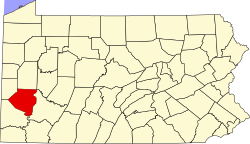Clairton, Pennsylvania | |
|---|---|
 Clairton in 1973 | |
| Nickname: City of Prayer | |
 Location of Clairton, Pennsylvania | |
| Coordinates: 40°17′48″N79°53′20″W / 40.296656°N 79.889026°W | |
| Country | United States |
| State | Pennsylvania |
| County | Allegheny |
| Founded | April 12, 1903 |
| Incorporated (borough) | April 12, 1903 |
| Incorporated (city) | January 1, 1922 |
| Government | |
| • Mayor | Richard Lattanzi |
| • Deputy mayor | R. Tony Kurta |
| • City Council | Eric Hatchett Lee Lasich Lamont Lewis |
| Area | |
• Total | 2.995 sq mi (7.757 km2) |
| • Land | 2.769 sq mi (7.172 km2) |
| • Water | 0.226 sq mi (0.585 km2) 7.55% |
| Elevation | 850 ft (259 m) |
| Population | |
• Total | 6,181 |
| 5,945 | |
| • Density | 2,147/sq mi (828.9/km2) |
| Time zone | UTC–5 (Eastern (EST)) |
| • Summer (DST) | UTC–4 (EDT) |
| ZIP Code | 15025 |
| Area code | 412 |
| FIPS code | 42-13704 |
| GNIS feature ID | 1214783 [3] |
| Sales tax | 7.0% [6] |
| Website | cityofclairton.com |
Clairton is a city in Allegheny County, Pennsylvania, United States. It is located along the Monongahela River and is part of the Pittsburgh metropolitan area. The population was 6,181 at the 2020 census, [4] and was estimated to be 5,945 in 2024. [5] Under Pennsylvania legal classifications for local governments, Clairton is considered a third-class city. It is home to U.S. Steel's Clairton Coke Works, the largest coke manufacturing facility in North America.
Contents
- History
- Geography
- Surrounding and adjacent neighborhoods
- Demographics
- 2020 census
- 2010 census
- 2000 census
- Government and politics
- In popular culture
- Notable people
- References
- External links
The city was the setting for the movie The Deer Hunter (1978), although none of the movie was actually filmed there (other mill towns in the Monongahela River Valley and elsewhere in the tri-state area were used).
The Montour Trail, a recreational rail-trail, extends from Clairton to Coraopolis, Pennsylvania.


